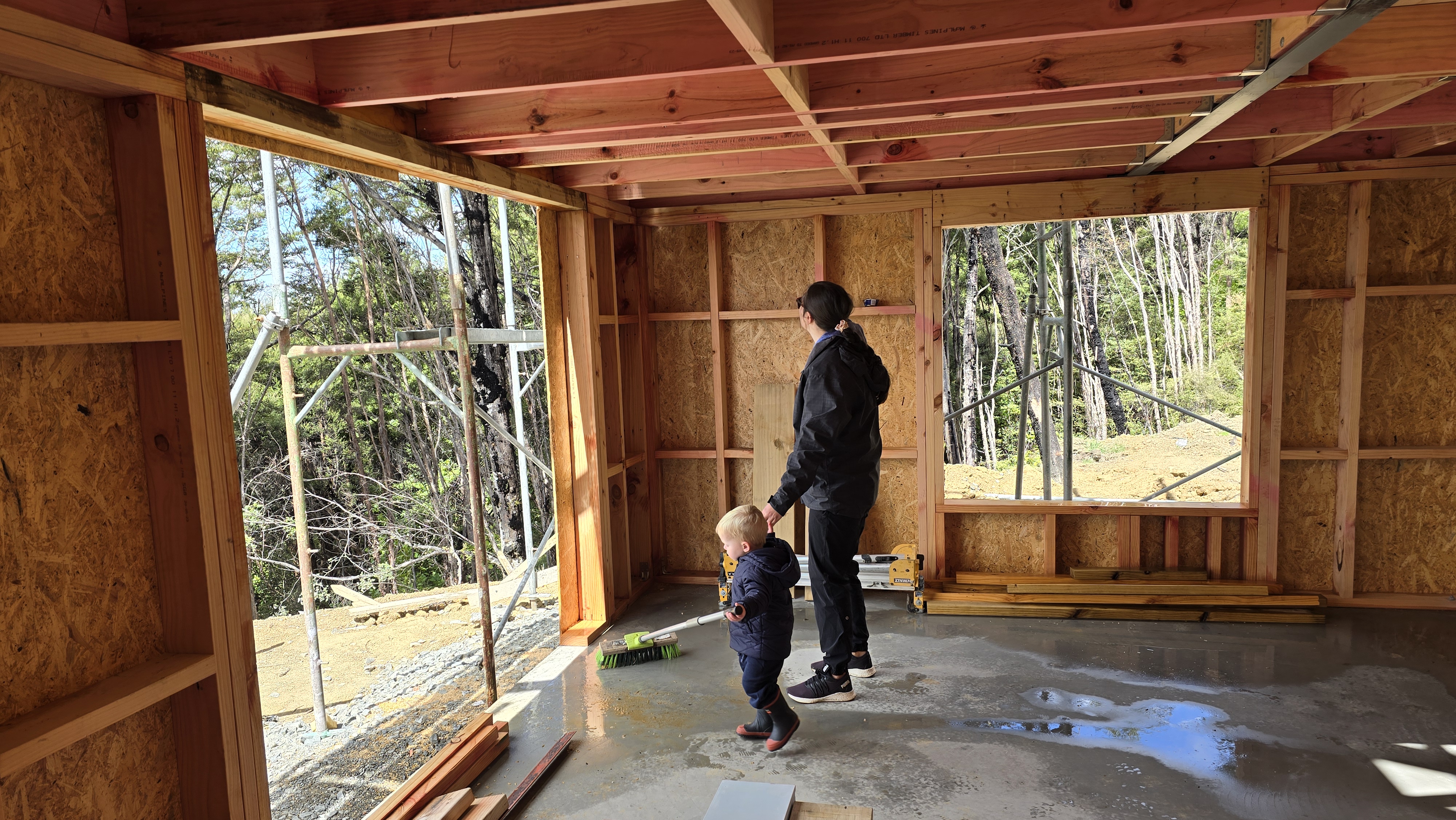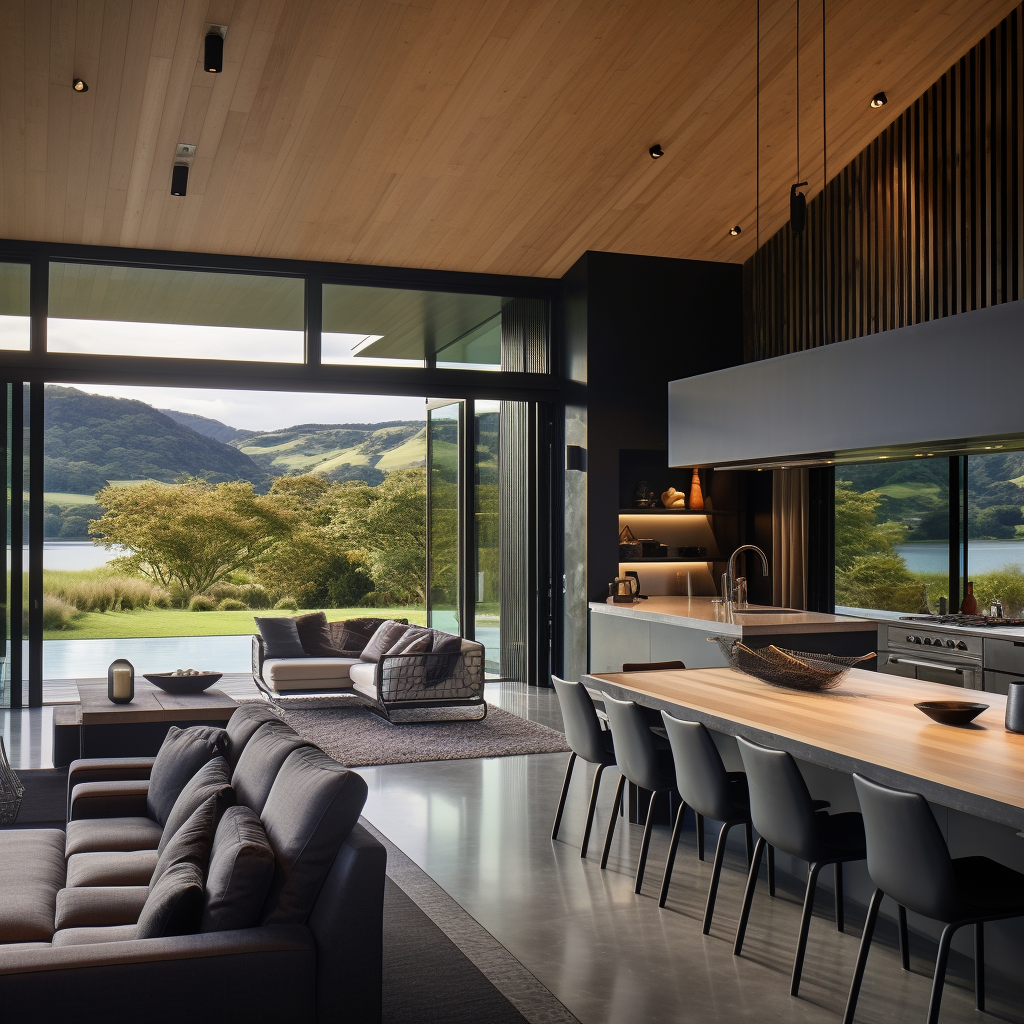How Modern Building Practices Can Affect Your Health
When planning a new home, most people focus on factors like cost, layout, and energy efficiency. What often gets overlooked is the impact that building materials and construction methods can have on health, both in the short term and well into the future. In many modern New Zealand homes, practices aimed at improving performance or reducing expense can unintentionally introduce risks to indoor air quality, moisture control, and overall wellbeing.
This guide highlights ten common features in new residential builds that may compromise occupant health. While these issues are often hidden and develop slowly over time, they are not inevitable. With careful planning and informed decisions about materials, ventilation, and design, it is possible to avoid these problems and create a home that supports both comfort and long-term health.
Acronyms used:
VOC – Volatile Organic Compound
A class of carbon-based chemicals that easily become vapours or gases. Common in synthetic building materials, adhesives, paints, and finishes, VOCs can negatively affect indoor air quality and cause short- or long-term health effects such as headaches, respiratory irritation, and dizziness.
EPS – Expanded Polystyrene
A lightweight, rigid foam plastic commonly used for insulation. EPS offers good thermal resistance but does not manage moisture well and can off-gas chemicals over time if not properly sealed or ventilated.
MDF – Medium-Density Fibreboard
An engineered wood product made by breaking down hardwood or softwood residuals into wood fibres and combining them with wax and a resin binder, usually formaldehyde-based. MDF is commonly used in cabinetry and furniture but may release formaldehyde gas over time.
CCA – Copper Chromium Arsenate
A chemical wood preservative containing compounds of copper, chromium, and arsenic. Used to protect timber from decay and insect attack, CCA-treated wood may pose health risks due to arsenic leaching, especially in indoor or poorly ventilated areas.
CO₂ – Carbon Dioxide
A naturally occurring gas that can accumulate in enclosed spaces without adequate ventilation. Elevated indoor CO₂ levels may lead to reduced concentration, headaches, drowsiness, and a general sense of stale air.
1. Moisture Trapping Within Wall Cavities
One of the most overlooked but serious risks in modern residential construction is the unintended trapping of moisture within wall systems. As building codes have evolved to prioritise energy efficiency, many homes have become increasingly airtight. While this can help reduce heat loss and lower energy usage, it also limits the natural movement of air and vapour. Without appropriate design and materials that allow moisture to pass through the building envelope, condensation can become trapped behind internal linings and inside wall cavities.
Moisture ingress may not be immediately visible. In many homes, it builds up silently over months or even years. The risk is particularly high in areas with poor ventilation or where vapour-impermeable materials such as plastic membranes or standard paint systems are used without adequate planning. Trapped moisture creates an ideal environment for mould spores to grow, especially when combined with warmth and darkness. These spores can then travel into the indoor air, where they are inhaled by occupants.
The health effects of indoor mould exposure are well documented. It can cause or worsen respiratory issues such as asthma, trigger allergic reactions, and contribute to chronic sinus problems. Children, the elderly, and those with compromised immune systems are particularly vulnerable. Prolonged exposure to elevated indoor humidity and fungal spores can lead to long-term health consequences, including persistent fatigue, skin irritation, and sleep disruption.
Aside from its direct impact on human health, trapped moisture also compromises the durability and integrity of the building itself. Over time, water in hidden areas can degrade insulation performance, corrode fixings, and cause timber framing to rot. Repairing this kind of damage is often costly and invasive, especially if it goes unnoticed until serious symptoms appear.
To avoid this, breathable materials and vapour-permeable systems such as Magnum Board and vapour-permeable paints are increasingly being adopted in health-based building design. These materials allow moisture vapour to exit the building structure while still preventing liquid water from entering. This helps maintain a stable and dry environment inside the walls.
Passive ventilation design also plays a critical role. By encouraging natural airflow and minimising humidity buildup, designers can support the movement of air and moisture through the structure. When combined with proper insulation and careful detailing around windows, doors, and junctions, a breathable wall system can significantly reduce the risk of long-term moisture accumulation.
New Zealand’s variable climate makes these issues particularly important. Regions with high humidity or cold winters are especially vulnerable to internal condensation if the building fabric is not designed to manage moisture effectively. Preventing trapped moisture should be seen as a fundamental consideration for both health and performance rather than as a minor technical detail.
2. Use of Composite Wood Products
Composite wood products are widely used in modern homes for cabinetry, internal doors, wardrobes, shelving, and even some structural applications. These materials, most commonly medium-density fibreboard (MDF) and particleboard, are manufactured by binding wood fibres or chips together using synthetic resins. While this process allows for efficient use of timber offcuts and consistent product quality, it comes with a hidden cost in the form of chemical emissions into the indoor environment.
The resins used in composite wood products frequently contain urea-formaldehyde, a substance known for its strong bonding properties and cost efficiency. Unfortunately, formaldehyde is a volatile organic compound (VOC) that can off-gas from finished panels for months or even years. This process releases formaldehyde vapour into the indoor air, particularly in warm or poorly ventilated spaces. Even at low concentrations, formaldehyde can cause irritation to the eyes, nose, and throat. In more severe cases, it may lead to coughing, breathing discomfort, or allergic-type reactions.
Formaldehyde has been classified as a known human carcinogen by the International Agency for Research on Cancer (IARC). Long-term exposure has been linked to an increased risk of nasopharyngeal cancer and leukaemia. These risks are more significant in enclosed indoor environments where air circulation is limited and composite wood is used extensively, such as in new kitchens or fitted storage areas. Children are particularly sensitive to the effects because of their smaller body size and developing respiratory systems.
The use of composite wood can also contribute to cumulative exposure when combined with other sources of VOCs, such as paints, flooring adhesives, and soft furnishings. Together, these materials can significantly reduce the overall indoor air quality of a home, especially during the early months following construction or renovation.
Minimising these risks begins with careful material selection. Low-formaldehyde or formaldehyde-free board options are now available from a range of suppliers. Products labelled E0 or those that meet international low-emission standards can reduce or eliminate off-gassing concerns. Using solid timber, plywood with natural adhesives, or magnesium-based alternatives such as Magnum Board for cabinetry or linings may also help reduce exposure risk.
Ventilation is another critical consideration. Allowing fresh air to circulate during and after installation helps reduce the accumulation of airborne VOCs. Where practical, it is best to avoid sealing enclosed spaces such as wardrobes or cupboards immediately after installation. Natural air movement supports the dispersal of gases before they can build up to harmful levels.
In a health-based building approach, the use of composite wood products is either minimised or carefully specified to align with indoor air quality standards. This reflects a growing understanding that the materials used in construction continue to influence the indoor environment long after the work is complete. For homeowners and designers prioritising health and long-term wellbeing, choosing the right materials from the beginning is a critical step.
3. Synthetic Insulation Materials
Insulation plays a vital role in the comfort and energy efficiency of any home. In recent decades, synthetic insulation products such as fibreglass batts, expanded polystyrene (EPS), and polyurethane foams have become widely used across New Zealand due to their affordability and high thermal resistance. While these materials can improve a building’s energy performance on paper, they often fall short when it comes to supporting a healthy internal environment.
One of the major concerns with synthetic insulation is its tendency to off-gas volatile organic compounds (VOCs). These airborne chemicals can be released from certain synthetic foams and the binders used during the manufacturing process. When insulation is installed in enclosed spaces, particularly in airtight modern homes, these compounds may accumulate and degrade indoor air quality. Prolonged exposure can lead to symptoms such as eye and throat irritation, fatigue, dizziness, and, in some cases, asthma or other chronic respiratory conditions.
Synthetic insulation also lacks the ability to regulate moisture. Materials like polystyrene and fibreglass are designed to resist water, but they do not absorb, buffer, or help stabilise humidity levels. In high-humidity environments or homes with insufficient ventilation, condensation can form around or behind insulation layers. This trapped moisture can then promote mould growth on nearby materials such as timber framing or internal linings. While the insulation itself may not be the direct source of mould, its inability to assist in moisture control means it can still contribute to poor indoor conditions.
There are also installation-related health risks to consider. Handling fibreglass insulation can release fine glass fibres into the air, which may irritate the lungs and skin when inhaled or touched. While protective equipment can reduce this risk, it does raise concerns about long-term exposure, particularly if insulation is disturbed later during maintenance, renovation, or repair work.
Insulation should do more than just slow heat transfer. From a building science perspective, it should work in harmony with the natural vapour movement within a home. Materials that are both thermally insulative and vapour-permeable, such as sheep’s wool, are better suited for supporting indoor air quality and managing humidity. Sheep’s wool, which features in the Foreverbreathe Specification, also provides an exothermic response, helping the home maintain a more even temperature throughout seasonal changes.
As awareness of healthy home design grows, more builders and homeowners are moving away from synthetic insulation and toward natural or low-toxicity alternatives. The aim is to create homes that not only perform well thermally but also support human wellbeing. By choosing insulation materials that balance temperature and moisture while minimising harmful emissions, it is possible to achieve a more resilient, breathable, and comfortable home environment.
4. Chemically Treated Building Materials
In New Zealand, many standard building materials, especially timber, are chemically treated to prevent damage from insects, fungal decay, or moisture exposure. While this increases durability and meets building code requirements, it also introduces health concerns that are often underestimated.
Most timber used in structural framing, decking, and outdoor elements is treated with preservatives such as copper chromium arsenate (CCA), boron compounds, or synthetic fungicides. These chemicals are designed to remain within the timber and provide protection over time, but they do not remain completely stable. In high-humidity environments or when materials are subject to wear and friction, small amounts can leach into the surrounding environment through airborne particles, surface contact, or gradual breakdown.
For homeowners, this creates a potential risk of exposure through inhalation or skin absorption, especially during construction, renovation, or demolition activities. Arsenic, which is found in CCA-treated timber, is a known toxin and a suspected carcinogen. Ongoing exposure, even at low levels, may lead to chronic health effects including skin irritation, neurological symptoms, and impaired immune function.
Interior features made from treated timber can pose added risks if not properly sealed or finished. Wardrobes, skirting boards, or exposed framing elements inside living areas may slowly release chemicals into the indoor air. In homes with poor ventilation, these emissions can accumulate and lead to long-term exposure.
Children face increased vulnerability because they are more likely to come into contact with floor surfaces and often spend extended periods indoors. People with respiratory conditions or chemical sensitivities may also experience stronger reactions when exposed to low levels of contaminants over time.
Where possible, untreated or low-toxicity materials should be used instead. Naturally durable timbers or those treated with safer alternatives, such as thermal modification or boron, offer a healthier option. If treated timber must be used indoors, it should be sealed completely, located away from high-use areas, or placed where contact and airflow are limited.
Health-based building design also accounts for how different materials interact over time. Using breathable linings alongside chemically stable structural components reduces the risk of hidden emissions and supports better long-term air quality. This principle is central to the Foreverbreathe Specification, which avoids conventional chemical treatments and prioritises systems that safeguard occupant health.
Durability should not come at the cost of indoor air quality. By knowing what is in the materials and where they are used within the home, better-informed choices can be made to protect both the people living in the space and the long-term integrity of the building.
5. Low-Permeability Paints and Finishes
Paint plays an important role in the look and feel of a home, but it also has a direct impact on the home’s indoor environment. Many conventional paints and finishes, especially those designed for durability, moisture resistance, or a glossy finish, are classified as low-permeability or non-breathable. While these finishes may perform well aesthetically and resist staining, they often compromise a home’s ability to manage indoor moisture effectively.
Low-permeability paints form a barrier that restricts the movement of water vapour. This becomes a problem in homes with sealed wall systems, where vapour generated from daily activities such as cooking, showering, and even breathing is unable to escape. Over time, this trapped vapour can condense behind the painted surface, leading to hidden mould growth and deterioration of wall linings and timber framing. Because the issue occurs behind the visible surface, it may go undetected until substantial damage has occurred.
In addition to trapping moisture, many conventional paints emit volatile organic compounds (VOCs), especially during application and curing. Common VOCs found in standard paints include benzene, toluene, and xylene. These chemicals can cause short-term symptoms such as headaches, dizziness, and throat irritation. Prolonged or repeated exposure may contribute to respiratory conditions, fatigue, or more serious health effects. Children and individuals with chemical sensitivities are especially at risk.
Even once dry, some paint products continue to off-gas slowly over time, particularly in warm or poorly ventilated homes. In a tightly sealed new build, this off-gassing can accumulate and degrade indoor air quality significantly.
In contrast, vapour-permeable paints offer a healthier alternative. These finishes allow water vapour to pass through the paint layer, working in conjunction with breathable materials like Magnum Board and sheep’s wool insulation to create a moisture-balanced environment. They also tend to contain lower levels of VOCs and are often certified under environmental or health standards.
When specifying finishes for a new build or renovation, the type of paint selected should align with the broader goals of the building. In health-based homes, vapour-permeable paint is a critical part of an integrated system that supports indoor air quality, moisture control, and long-term durability.
As awareness of these risks grows, more New Zealand suppliers are offering low-VOC and breathable paint systems. Choosing products designed with health and performance in mind is a simple but important step that contributes to a more comfortable and safer living environment for everyone in the home.
6. Poor Humidity Control
Maintaining balanced indoor humidity is one of the most important yet commonly overlooked aspects of creating a healthy living environment. In both summer and winter, the indoor climate in modern New Zealand homes can fluctuate significantly. This is especially the case in homes that have been built to emphasise airtightness or use sealed surfaces throughout. When relative humidity moves outside the optimal range, typically between 40 and 60 percent, it can negatively affect both the health of the occupants and the integrity of the building.
Excess humidity encourages the growth of biological contaminants such as mould, mildew, dust mites, and bacteria. Mould spores thrive in damp conditions, particularly in areas with poor airflow where moisture is allowed to remain. Although kitchens, bathrooms, and laundries are the most common locations for humidity-related issues, bedrooms and living areas can also be affected. Condensation on windows or moisture accumulating in wall cavities may go unnoticed until damage is visible or symptoms appear.
When indoor humidity regularly exceeds 60 percent, it becomes increasingly difficult to prevent microbial growth. This can lead to the deterioration of internal finishes such as wall linings, window joinery, and timber framing. It also raises serious health concerns. Mould and bacteria are known to contribute to asthma, allergic reactions, respiratory infections, and prolonged illness. Children and elderly people are particularly vulnerable to these health impacts.
At the opposite end of the spectrum, air that is too dry can also cause discomfort and health problems. Indoor environments with relative humidity below 30 percent are most common during winter. When the air is excessively dry, the body’s mucous membranes can become irritated, reducing natural defences against airborne particles and viruses. In these conditions, people may also experience cracked skin, irritated eyes, and flare-ups of conditions such as eczema and sinusitis.
Many heating and cooling systems in modern homes do not actively regulate humidity. In winter, heat pumps and other systems may remove too much moisture from the air. In other cases, imbalanced systems can allow moisture to build up in certain areas, where it remains unnoticed. Without materials that naturally regulate vapour movement, indoor humidity levels are more likely to become unstable.
Health-focused building practices treat humidity management as a core design consideration. Materials such as sheep’s wool insulation, vapour-permeable linings, and breathable paints help to buffer humidity. These materials absorb and release moisture depending on changes in the indoor environment, helping to maintain a stable and comfortable atmosphere year-round.
Alongside these materials, passive ventilation and correctly sized mechanical extract systems are essential in high-moisture areas such as kitchens, bathrooms, and laundries. A digital hygrometer can also be a useful tool for households wanting to understand and improve their indoor humidity levels.
Managing indoor humidity is not simply a matter of comfort. It affects respiratory health, the long-term condition of the building, and the ongoing cost of maintenance. A well-designed home should support healthy humidity levels throughout the seasons, contributing to both better wellbeing and greater durability.
7. Over-Reliance on Mechanical Ventilation
Modern homes built to airtight standards often depend heavily on mechanical ventilation systems to maintain indoor air quality. While these systems are valuable and, in some cases, essential, they are not a complete solution. Over-reliance on mechanical ventilation, especially when the system is not properly designed, installed, or maintained, can introduce a range of health and performance concerns.
Mechanical systems are intended to extract stale air, remove excess humidity, and bring in fresh outdoor air. However, when these systems are undersized or poorly balanced, they may circulate air unevenly or fail to reach all areas of the home. In houses with sealed building envelopes and minimal natural airflow, this can lead to stagnant or humid air accumulating in certain zones. The result is often an increase in condensation, mould risk, and a general decline in air quality.
An additional concern is the distribution of airborne contaminants. Ducted ventilation systems can unintentionally move dust, pollen, or mould spores from one part of the house to another. Without regular cleaning or effective filtration, these particles can build up within the system and recirculate throughout the living space. In some situations, shared ducting may even spread bacteria or viruses between rooms, further compromising indoor health.
Noise and energy consumption also influence how these systems are used. Some households choose to switch off mechanical ventilation at night or during milder seasons to reduce noise or save on electricity. While understandable, this can lead to poor air quality and rising humidity, particularly in well-insulated and airtight homes. A ventilation system that only supports indoor air health when running constantly may not be practical for daily life.
Health effects from insufficient or poorly managed mechanical ventilation can include dry eyes, irritated respiratory passages, headaches, disrupted sleep, and increased susceptibility to respiratory illnesses. These symptoms often develop gradually but may intensify over time, especially when combined with other pollutants such as volatile organic compounds from paints, cabinetry, or flooring materials.
The most effective building designs combine mechanical ventilation with passive airflow strategies. Designing for natural air movement through features like operable windows, vented skylights, and breathable construction materials can support indoor comfort and reduce the need for continuous mechanical intervention.
Mechanical systems should enhance, not replace, thoughtful design. When mechanical ventilation is necessary, it should be tailored to the specific size and layout of the home. Systems should include easy access for cleaning and incorporate high-quality filters that are replaced at regular intervals. Ventilation technologies such as heat recovery or demand-controlled extraction can also help to balance performance, noise, and energy use more efficiently.
For homeowners, understanding how ventilation contributes to overall wellbeing is essential. Relying solely on mechanical systems without considering natural airflow or vapour-permeable materials can introduce ongoing risks. A well-balanced ventilation approach not only protects health but also supports year-round comfort and building durability.
8. Lack of Passive Airflow Design
Airflow is one of the most fundamental elements of a healthy home, yet in many modern builds it is treated as a secondary concern. As building envelopes become more airtight and energy-efficient, the natural movement of air is often reduced or eliminated. This increases dependence on mechanical systems and leaves homes at risk when those systems are not operating or are poorly maintained.
Passive airflow design involves the intentional planning of a building’s layout, openings, and materials to allow fresh air to circulate through the space without mechanical intervention. This can include the use of aligned windows for cross-ventilation, ventilated roof cavities, breathable wall systems, and vented claddings. When these features are excluded, homes may feel sealed, stale, and difficult to ventilate effectively.
Without passive airflow, several health concerns may arise. One of the most immediate effects is the accumulation of carbon dioxide, particularly in bedrooms and living areas where people spend the most time. Elevated levels of carbon dioxide have been linked to reduced mental clarity, decreased concentration, and poorer sleep quality. Over time, these conditions can contribute to fatigue, discomfort, and a general decline in wellbeing.
Lack of airflow also makes it difficult to flush out indoor pollutants. Everyday activities such as cooking, cleaning, or simply breathing release a range of particles and gases into the indoor environment. In a home without consistent air movement, these substances can build up, resulting in a stuffy, stagnant atmosphere that negatively affects both comfort and health.
Passive ventilation plays a critical role in managing temperature and moisture as well. During warmer seasons, the ability to open windows on opposite sides of the home helps draw in cooler air and release built-up heat. In winter, thoughtful airflow planning supports the removal of humidity from daily activities like showering and drying clothes, which reduces the risk of condensation on windows and within wall structures.
Reliance solely on powered systems can become especially problematic during power outages. Whether caused by storms, scheduled maintenance, or technical failures, a lack of electricity can turn a tightly sealed home into a humid and uncomfortable space within a short period. Passive airflow design provides a level of resilience that becomes particularly valuable in regions where weather disruptions are frequent or where energy efficiency goals are a high priority.
From a construction standpoint, incorporating passive ventilation is entirely achievable with proper planning. Key considerations include the strategic placement of windows and doors, the inclusion of operable skylights, the use of breathable materials, and orientation that takes advantage of prevailing wind patterns. These elements work together to ensure a continuous exchange of indoor and outdoor air.
Homes built without passive ventilation are typically harder to regulate and rely more heavily on mechanical solutions for heating, cooling, and air exchange. For those who prioritise comfort, indoor health, and sustainability, a carefully integrated passive airflow strategy offers clear long-term benefits. It improves indoor air quality, reduces energy consumption, and supports a more comfortable and resilient home throughout the year.
9. Insufficient Thermal Regulation
Thermal comfort is a critical part of wellbeing at home. It influences sleep quality, productivity, stress levels, and even immune function. Yet many new builds in New Zealand still struggle to maintain stable indoor temperatures throughout the year, even with airtight construction and widespread use of insulation. Poor thermal regulation, whether a home is consistently too hot, too cold, or experiences sharp temperature swings between day and night, can place continuous strain on the people living inside.
When a home lacks adequate thermal balance, the body must work harder to maintain a stable internal temperature. In cold conditions, the body diverts energy toward staying warm, which can increase fatigue, irritability, and susceptibility to respiratory illness. Prolonged exposure to cold, even if mild, may also raise blood pressure and trigger discomfort in those with arthritis or circulation issues.
Conversely, homes that overheat during summer, particularly those with extensive glazing or poor ventilation, can cause restlessness, headaches, and dehydration. Overheating is especially problematic in bedrooms, where it disrupts sleep and affects recovery and cognitive function. Children and older adults are particularly sensitive to fluctuating indoor temperatures and may struggle to regulate their body temperature effectively.
In many homes, temperature issues arise from a mismatch between insulation, ventilation, and glazing design. Well-insulated homes without natural ventilation can trap heat during summer. At the same time, homes with poor insulation or areas of thermal bridging can become damp and cold in winter. These conditions may not cause immediate harm but can steadily degrade quality of life and contribute to secondary issues such as mould and condensation.
Humidity and temperature are closely linked. In colder months, poor thermal regulation can lead to internal cold spots, such as along uninsulated walls or under window frames, where condensation is likely to form. This repeated exposure to moisture can support hidden mould growth, affecting both occupant health and the integrity of the building. In warmer months, insufficient cross-ventilation can trap humidity indoors, adding to discomfort and raising the risk of bacterial growth.
Addressing thermal regulation requires a holistic design approach. It begins with selecting insulation materials that not only slow heat transfer but also help regulate humidity. Sheep’s wool insulation, for example, supports thermal and moisture balance. Effective thermal design also considers window placement, room zoning, shading, ventilation strategies, and the building’s orientation to the sun and prevailing winds. The choice of cladding and interior finishes further influences how well a home retains or releases heat.
A well-regulated home requires less intervention from active heating and cooling systems. By remaining comfortable through passive design, the home can reduce energy use while supporting a calm, stable indoor environment. In health-based models like the Foreverbreathe Specification, thermal regulation is treated as a fundamental part of the building’s design rather than a late-stage response to external conditions.
10. Interior Dust and Off-Gassing from New Materials
A freshly built home may look clean and modern, but the indoor air in those early weeks and months often contains a range of chemical compounds and particulates that can affect comfort and health. This issue is commonly referred to as “off-gassing,” and it occurs when materials such as carpet, vinyl flooring, adhesives, sealants, and even furniture release volatile organic compounds (VOCs) into the air.
Many VOCs used in new building materials are associated with short-term symptoms like headaches, fatigue, watery eyes, skin irritation, and sinus congestion. In enclosed or poorly ventilated spaces, these effects can be felt more intensely. People with asthma, allergies, or chemical sensitivities are particularly vulnerable. Children and infants are also at greater risk due to their developing respiratory systems and proportionally higher breathing rates.
Off-gassing is most concentrated immediately after installation but can persist for weeks or even months, depending on the material and indoor conditions. Heat and humidity accelerate the release of VOCs. This means that newly built or renovated homes are especially susceptible during warmer months. Standard synthetic carpets, for example, are often backed with latex or rubber and installed with solvent-based adhesives. Both can emit measurable quantities of chemicals into the indoor environment.
In addition to VOCs, interior finishes may contribute to dust accumulation and chemical residues on surfaces. As materials settle, particulates from plasterboard, flooring, and cabinetry can circulate in the air or settle on horizontal surfaces. If not cleaned regularly or managed with appropriate airflow, these dust particles can cause respiratory irritation and reduce overall indoor air quality.
New occupants often describe a distinct chemical odour when moving into a new home. Although the smell usually fades with time, the compounds responsible may remain in the air at low levels for an extended period. Without proper ventilation, these compounds can build up, particularly in closed spaces such as bedrooms, wardrobes, and storage areas.
To reduce exposure to indoor pollutants from new materials, health-based building design favours natural and low-emission products. These include low-VOC paints and sealants, natural fibre carpets, water-based adhesives, and untreated or sustainably processed timber. Materials that have been third-party certified under environmental or indoor air quality standards provide reassurance that emissions have been tested and kept within safe limits.
Breathable materials also support healthier indoor environments. When combined with effective airflow design - through either passive ventilation or filtered mechanical systems - they help disperse airborne chemicals and maintain a more balanced and breathable space.
Finally, post-construction airing out of the home is essential. Regularly opening windows, using extractor fans, and avoiding the complete sealing of cupboards or rooms in the first few weeks can help reduce VOC concentrations. Occupants may also benefit from using indoor plants, HEPA-filter air purifiers, or mechanical ventilation systems that bring in fresh outdoor air.
Although off-gassing is often temporary, the exposure during this initial occupancy phase can be meaningful. By choosing healthier materials and managing ventilation carefully, the move into a new home can be made more comfortable and significantly safer for everyone living there.
Summary:
A well-considered home is more than just walls, windows, and insulation. The way a house is designed and the materials used in its construction have direct and measurable effects on the health of those who live in it. These effects appear not just in the first few weeks after moving in, but across years and even decades. The choices made at the design and build stage carry consequences that shape daily comfort, resilience, and wellbeing over time.
In the short term, occupants may experience immediate reactions to off-gassing from synthetic carpets, adhesives, composite wood, or paints. These exposures can trigger headaches, irritation, respiratory issues, and fatigue, especially for sensitive individuals such as children, the elderly, or those with asthma. Moisture trapped in wall cavities or under flooring may not be visible, but can create the ideal conditions for hidden mould to take hold. Symptoms may seem mild or intermittent, but they often go misdiagnosed or unnoticed until they become more persistent.
In the medium term, poor thermal regulation, lack of humidity control, and insufficient ventilation can cause more entrenched health issues. Conditions such as eczema, chronic sinus infections, sleep disruption, and lowered cognitive function often emerge gradually. A home that is too damp, too dry, or poorly ventilated becomes a place that does not support restoration or rest. Instead, it becomes an environment that slowly undermines health and comfort. These impacts extend to mental health as well, as discomfort, fatigue, and illness accumulate into stress and strain.
Over the long term, exposure to indoor pollutants such as volatile organic compounds, formaldehyde, or residues from chemically treated materials increases the risk of more serious conditions. These include respiratory disease, immune system disruption, and in some cases, exposure to carcinogenic substances. For families raising children in these environments, the long-term health trajectory of those children can be shaped by decisions made long before they took their first steps. For older adults or people with chronic health concerns, the indoor environment can either support recovery or add to their burden.
From a financial perspective, homes built with breathable, low-toxicity, and moisture-regulating materials do require more planning and often a slightly higher upfront investment. But these costs are not lost. In markets that increasingly value sustainability, durability, and occupant wellbeing, well-designed healthy homes command a premium. Sales data and buyer interest in high-performance properties continue to rise, reflecting growing awareness of these benefits. A healthier home not only preserves physical wellbeing but retains long-term value in the property market.
When health is placed at the centre of the design process, every element of the home contributes to a better daily experience. Air feels fresher, temperatures are more stable, and mould or dust buildup becomes less of a concern. These qualities reduce the need for costly remediation or medical intervention and offer a quality of life that extends well beyond construction. The investment pays off not only in dollars, but in years of easier breathing, deeper sleep, and a stronger foundation for the people living within its walls.
If you’d like to explore how to build with health and wellbeing in mind, we recommend reaching out to our trusted partners for expert guidance.
Health Based Building: https://www.healthbasedbuilding.com/foreverbreathe-specification
Premium Homes: https://premhomes.co.nz/why-go-green
Keywords for Internal Search:
healthy home design, indoor air quality nz, off-gassing from new materials, vocs in building materials, formaldehyde in mdf, moisture in wall cavities, breathable building materials, passive ventilation systems, passive house design nz, natural insulation options, sheep’s wool insulation nz, low-voc paints nz, composite wood health risks, synthetic insulation dangers, thermal comfort in homes, regulating indoor humidity, mould in new homes, hidden moisture problems, sustainable building nz, airtight homes and ventilation, health effects of cca timber, new build health risks, indoor pollutants in homes, humidity and respiratory health, ventilation in airtight homes, carbon dioxide in bedrooms, building envelope moisture issues, heat regulation in homes, thermal bridging and dampness, condensation on windows, indoor air contaminants, sustainable home construction nz, healthy building practices, foreverbreathe specification, health effects of modern homes, new home dust and toxins, air quality and cognitive function, low-emission home materials, nz climate and home design, natural airflow in homes, mechanical ventilation pros and cons, house overheating in summer, cold spots in winter homes, allergen buildup in new homes, energy efficient healthy homes, vocs in adhesives and sealants, chemical residues in new builds, natural building product benefits, durable breathable materials, resale value of healthy homes, health-based building choices






